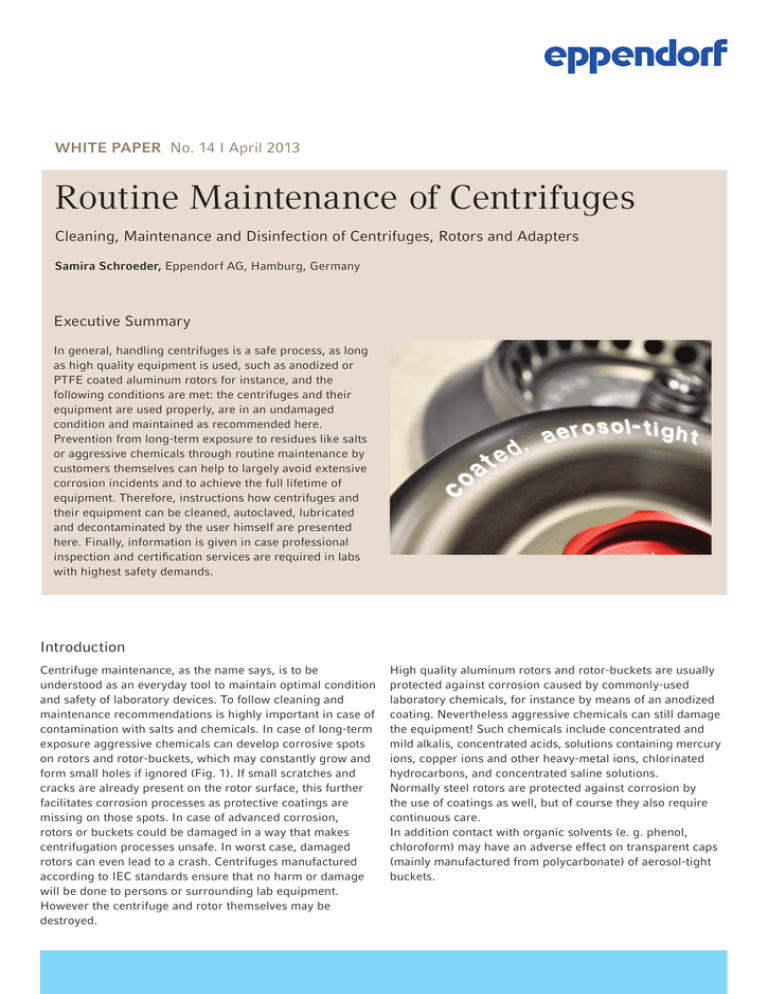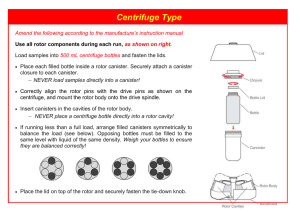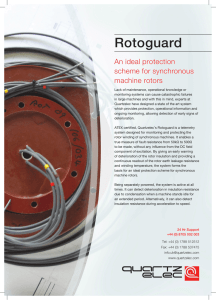
WHITE PAPER No. 14 I April 2013
Routine Maintenance of Centrifuges
Cleaning, Maintenance and Disinfection of Centrifuges, Rotors and Adapters
Samira Schroeder, Eppendorf AG, Hamburg, Germany
Executive Summary
In general, handling centrifuges is a safe process, as long
as high quality equipment is used, such as anodized or
PTFE coated aluminum rotors for instance, and the
following conditions are met: the centrifuges and their
equipment are used properly, are in an undamaged
condition and maintained as recommended here.
Prevention from long-term exposure to residues like salts
or aggressive chemicals through routine maintenance by
customers themselves can help to largely avoid extensive
corrosion incidents and to achieve the full lifetime of
equipment. Therefore, instructions how centrifuges and
their equipment can be cleaned, autoclaved, lubricated
and decontaminated by the user himself are presented
here. Finally, information is given in case professional
inspection and certification services are required in labs
with highest safety demands.
Introduction
Centrifuge maintenance, as the name says, is to be
understood as an everyday tool to maintain optimal condition
and safety of laboratory devices. To follow cleaning and
maintenance recommendations is highly important in case of
contamination with salts and chemicals. In case of long-term
exposure aggressive chemicals can develop corrosive spots
on rotors and rotor-buckets, which may constantly grow and
form small holes if ignored (Fig. 1). If small scratches and
cracks are already present on the rotor surface, this further
facilitates corrosion processes as protective coatings are
missing on those spots. In case of advanced corrosion,
rotors or buckets could be damaged in a way that makes
centrifugation processes unsafe. In worst case, damaged
rotors can even lead to a crash. Centrifuges manufactured
according to IEC standards ensure that no harm or damage
will be done to persons or surrounding lab equipment.
However the centrifuge and rotor themselves may be
destroyed.
High quality aluminum rotors and rotor-buckets are usually
protected against corrosion caused by commonly-used
laboratory chemicals, for instance by means of an anodized
coating. Nevertheless aggressive chemicals can still damage
the equipment! Such chemicals include concentrated and
mild alkalis, concentrated acids, solutions containing mercury
ions, copper ions and other heavy-metal ions, chlorinated
hydrocarbons, and concentrated saline solutions.
Normally steel rotors are protected against corrosion by
the use of coatings as well, but of course they also require
continuous care.
In addition contact with organic solvents (e. g. phenol,
chloroform) may have an adverse effect on transparent caps
(mainly manufactured from polycarbonate) of aerosol-tight
buckets.
WHITE PAPER I No. 14 I Page 2
We recommend checking the rotors and rotor bores visually
for residue and corrosion on a weekly or monthly basis.
Rotors, buckets, lids or adapters, which have been subject
to chemical or mechanical damage or which have exceeded
their maximum operating life, should not be used any longer.
Damaged tubes or plates should not be centrifuged.
Important information regarding cleaning and maintenance
can not only be found in this paper, but also in the operating
manual of your centrifuge. If unsure about the cleaning or
decontamination methods of the centrifuge or rotor, one
should contact the manufacturer and follow his
recommendation. If in doubt whether a rotor is still safe, an
authorized technician should be contacted.
Figure 1: Localized
corrosion in bore hole
Cleaning, Maintenance and Disinfection
Centrifuges
Remove buckets and rotor from the centrifuge. For
refrigerated centrifuges: Leave centrifuge lid open and
defrost the ice on the rotor chamber surface. If your
centrifuge is equipped with a water collection tray, empty
and clean it, then wipe the rotor chamber with a moist
cloth. The outside of the centrifuge and the rotor chamber
should be cleaned regularly with a moist cloth and neutral
detergents (Fig. 2). Switch off the centrifuge, before you do so.
Figure 2: Wipe outside of centrifuge and clean rotor chamber and rotor with moist cloth and neutral detergents.
In the event of contamination caused by high-risk substances
(bio hazardous or aggressive chemical reagents and
radioactive reagents) wear a laboratory coat, gloves and
goggles. If there is broken glass: Retrieve the bigger broken
glass with forceps, remove small and powder shards with a
damp lint-free cloth. Absorb blood with gauze or paper towel
and subsequently, seal the material in a biohazard bag for
safe disposal (Fig. 3). Wipe the contaminated parts with
neutral agents for cleaning and disinfection (e.g. diluted
neutral alcohol-based disinfectant or 70 % isopropanol
mixture). Use a soaked gauze or lint-free cloth.
If necessary, remove still contaminated rotor, rotor lid, buckets,
and bucket caps out of centrifuge to decontaminate areas
which are difficult to access. After decontamination the
equipment should be wiped with distilled water.
Figure 3:
Decontamination
of centrifuge, rotor
and rotor buckets.
WHITE PAPER I No. 14 I Page 3
Rotors, adapters, buckets and rubber seal
Use neutral cleaning solutions (alcohol or alcohol-based
disinfectant) and a soft cloth to clean your rotors and
accessories. Wipe contaminated parts with neutral agents
for cleaning and disinfection (e.g. diluted neutral alcoholbased disinfectant or 70 % isopropanol mixture). Use a
soaked gauze or lint-free cloth.
In case of spilling some aggressive liquid on your centrifuge
equipment, please clean it immediately. If there is stubborn
stain, clean with a plastic scrub pad and rinse equipment
with distilled water. Avoid immersing the rotor in water as
liquid could flow into rotor cavities, and dry thoroughly with
a soft cleaning cloth.
As salt crystals located on metal surface will corrode the
surface, we strongly recommend cleaning rotors and buckets
immediately. If there is a need to clean the rotor’s tube cavities
or boreholes, use a stiff test-tube brush that has end bristles
and a non-metallic tip.
For swing-bucket rotors, ensure that the grooves in which
the buckets are fitted are free of contamination. Take care to
ensure that the buckets can still swing freely.
Figure 4: Clean rotor and rotor bores with plastic scrub pad and/or stiff test-tube brush in case of stubborn stain. Then rinse with water and dry.
After decontamination the equipment should be wiped with
distilled water. If needed, autoclave rotor, rotor lids and
buckets as recommended by the manufacturer. Never use
UV, beta, gamma radiation, or any high-energy radiation
source. Place parts on dry cloth upside down to dry (Fig. 4).
Alternatively dry rotors, rotor boreholes and accessories
with absorbent towels. To prevent aerosol-tight lids/caps
and seals from getting worn out/damaged, store lids/caps
separately from the bucket/rotor.
Caution:
Do not use acetone, caustic detergents, or detergents that contain chlorite ions. Corrosion is most frequently
caused by using chlorite ion solutions, such as sodium hypochlorite (household bleach). Do not use steel wool,
wire brushes, abrasives, or sandpaper, since they may damage the rotor coating (anodized coating) and thus
increase the risk for corrosion. We do not recommend usage of dishwashers for rotors or lids due to the
aggressive cleaning agents used in these devices. These agents may result in corrosion.
WHITE PAPER I No. 14 I Page 4
Autoclaving
To protect human beings from pathogens or samples from
contamination, sterilization of rotors and accessories might
be desirable. Sterilization is a term referred to a process that
eliminates all forms of microbial life, including transmissible
agents such as bacteria, viruses, fungi, spore forms etc.
A widely-used method for heat sterilization is autoclaving,
where hot steam sterilizes equipment and other objects.
A typical autoclaving program is performed at 121 °C and
2 bar atmospheric pressure for 15 to 20 min for instance.
A few rotors in the market have been tested for autoclaving
at 121 °C. Especially the aluminum made fixed-angle and
swing-out rotors from Eppendorf have been vigorously
tested and approved within this setting. They possess a
special anodized coating which protects the metal from
deeper corrosion effects. Steel made rotors are commonly
of limited suitability for autoclaving. If you are in doubt
about your rotor, please ask the manufacturer about
autoclaving possibilities.
To achieve an outstanding chemical resistance against
phenol, acetonitrile, DMSO, acetone, trichloroacetic acid,
acetic acid and sodium hypochlorite, Eppendorf offers a
second type of aluminum fixed-angle rotor with a special
PTFE coating. This coating is applied on top of the actual
anodic coating. Autoclaving (121 °C, 20 min.) this rotor type
•
•
•
even improves the already enhanced chemical resistance
due to the material properties of the coating.
However, prions, such as those associated with CreutzfeldtJakob disease, may not be destroyed by autoclaving at the
typical 121 °C for 20 minutes. Some manufacturers state
that autoclaving at 134 °C for at least 18 minutes should
usually be sufficient [1]. But in some cases this also is not
enough to deactivate the agent of disease, especially if you
use material with very high infectiousness. The prions are
generally quite resistant to heat, although their infectivity
can be reduced by such a treatment. To destroy prions,
rotors which are only tested to be autoclaved at a max
temperature of 121 °C are therefore not suitable for such an
application. According to available marketing material, only
a few rotors in the market are allowed to be autoclaved at
higher temperatures. But are the rotors really tested within
this setting? Only very few companies can provide customers
with rotors really being tested with higher temperatures
than 121 °C. So in this application field, the customer has a
very limited choice of available rotors, including Eppendorf’s
high quality aluminum made rotors. Selected Eppendorf
rotors were extensively tested at 142 °C for 2 hours. These
Eppendorf rotors can be used with confidence for such an
application.
You should exchange aerosol tight lids after each autoclaving run at 142 °C to guarantee
the aerosol-tightness.
Never autoclave the rotor with the lid attached.
Please check recommendations in your rotor »instructions for use« info or contact the manufacturer’s
application support, if you are in doubt.
WHITE PAPER I No. 14 I Page 5
Lubrication
After cleaning your equipment take a small amount of
centrifuge lubricant (e.g. glycerol, talcum or peg fat from
Eppendorf, order number 5810 350.050) onto your finger.
Lubricate bucket grooves, pivots of swing-bucket rotors, and
rubber seals (Fig. 5). Check if seals of aerosol tight lids/caps
need to be replaced. Aerosol-tightness is limited to
undamaged seals. Lubricate the threads of the fixed angle
rotors after cleaning and autoclaving. Light waxing of the
rotor surface may also extend the life-time of the anodized
surface. Use a soft cloth for waxing procedure.
Figure 5: Lubrication of bucket grooves and pivots of swing-bucket rotor equipment, rubber seals, as well as threads of fixed-angle rotors.
Decontamination/Disinfection
Even when working accurately, a contamination of the rotor
by biological (for example blood) or radioactive material
may happen. Please consult your laboratory safety officer
first about suitable methods of cleaning and disinfecting any
hazardous spill within the centrifuge/rotor. Successful
disinfection can only be granted by the suppliers of the
chemicals. Before using any cleaning or disinfection method
other than the one recommended by the centrifuge
manufacturer, please check that the intended method will
not damage the rotors, accessories, or other parts of the
centrifuge. For decontamination, disinfection with alcoholcontaining liquids and autoclaving are the recommended
methods. Below you also find some recommendations for
disinfection reagents based on research done by Eppendorf.
You should not use UV, beta, gamma, or any other high-energy radiation source for disinfection.
Do not use any gassing for disinfection.
WHITE PAPER I No. 14 I Page 6
Examples of disinfection chemicals
Within the following table, some disinfection reagents are
presented (Table 1). Please be aware that the detergents and
disinfectants are only recommended due to their compatibility
with the robust materials of Eppendorf centrifuges. As
this is only a recommendation, no guarantee of safety is
expressed or implied. The test procedure was performed
under laboratory conditions with maximized care. The test
results are referred to the tested material. Liability for
preservation of the tested surfaces in combination with
incubation of disinfection reagents in practice based on the
test results cannot be assumed. Printed areas may be
discolored when being incubated with the disinfection
chemical.
In general, disinfection with a cloth is more efficient than
spraying only, which may also result in a short circuit within
the centrifuge housing. After cleaning with detergent, the
rubber seals in the rotor chamber should be rinsed well
with distilled water and lubricated with glycerol in order to
prevent the seals from becoming brittle.
Table 1: Resistance of Eppendorf rotors and buckets against common disinfection reagents
Disinfectant
Sterillium®
Bode Chemie®
Anodized aluminum
(fixed-angle rotors)
S
S
Polycarbonate
housing surface
S
Sterillium® Virugard
Bacillol® AF
Bode Chemie®
Bode Chemie®
(S)*
S
S
S
S*_
S*_
(S)p
Sp
Bacillol® plus
Bode Chemie®
S
S
S
S
Dismozon pur (5 %)
®
Bode Chemie
S
S
S*_
S
Korsolex® basic (conc.)
Bode Chemie®
S
S
S*_
S*_
Microbac® forte (conc.)
Bode Chemie®
S
S
S*_
S*_
Kohrsolin® FF (conc.)
Bode Chemie®
S
S
S*_
S*_
Desderman® pure (conc.)
Schülke Mayr
S
S
S
Sp
Mikrozid® AF
Schülke Mayr
S
S
S
S
Meliseptol®
Braun
S
S
S
S
Helipur®
Braun
S
S
S*_
S
Hexaquart® (2 %)
Braun
S
S
S
S
RNAse AWAY®
Molecular BioProducts
S
S
S
S
DNA AWAYTM
Molecular BioProducts
S
S
S
S
HI-TOR plus
Ecolab®
((S))* – M*
S
S*_
S
Sodium hypochlorite (12 %)
Ecolab®
((S))* – M*
M**
M*_
S
Barrycidal
Biohit®
S
S
S
S
Extran® MA 02 neutral
Merck
S
S
M*_
S*
Count-OffTM
Perkin Elmer®
U
M**
M
M
Isopropanol (70 %)
Perkin Elmer®
(S)*
S
S
Sp
Ethanol (70 %)
Perkin Elmer
S
S
S
S
®
Provider
S = Satisfactory resistance
M= Marginal resistance
U = Unsatisfactory resistance
_ = coating/ film (mostly reversible)
* = slight discoloration
**= discoloration
p = discoloration of printing (housing)
®
Anodized aluminum
(buckets)
S
Stainless steel
WHITE PAPER I No. 14 I Page 7
Conclusion
Cleaning and routine maintenance
(can be performed by user)
Sufficient awareness about the need of proper centrifuge
care is important. Long term exposure to contaminants like
salts or chemicals may affect the equipment by developing
corrosive sites. Continuous failure of cleaning and routine
maintenance will enhance the chemical wear. Loss of material
and even holes in the equipment may result in the worst
case. Therefore, checking the rotors and rotor bores visually
for residue and corrosion on a weekly or monthly basis is
suggested. If needed, following the described cleaning and
routine maintenance procedures is recommended. Rotors or
buckets, if damaged, should be replaced to avoid possible
rotor crashes. A technician might be asked if in doubt.
If these instructions are being followed, the centrifuge
operator will be provided with confidence all around
centrifuges. He will be able to guide other team members
and spread a consciousness for proper centrifuge care.
Furthermore, in this paper an insight into the variety of
different rotor quality levels was given. Good chemical
resistance of aluminum rotors is achieved when anodized
coating is present, as it is the case for all Eppendorf aluminum
made rotors as a standard. If outstanding resistance is
essential, because of regular work with aggressive solvents
such as phenol, acetonitrile, DMSO, acetone, trichloroacetic
acid, acetic acid and sodium hypochlorite, Eppendorf offers
special PTFE coated fixed-angle aluminum rotors.
In summary: Good quality rotors as those from Eppendorf
and proper centrifuge care performed as recommended
will support a safe working standard in the laboratory and
extend the life-time of centrifuge equipment to its maximum.
On top, Eppendorf offers professional inspection and
certification services for customers with highest lab safety
demands.
Eppendorf Rotor Assurance Plans
(performed by Eppendorf service technician)
As rotors and buckets are subject to normal wear and tear,
over the years, all rotor structures will eventually suffer from
fatigue due to the stress of high numbers of cycles.
If not maintained correctly, surface scratches can lead to
microscopic cracks, followed by critical cracks. Regular
qualified inspection of the rotor equipment will detect
damages early in order to prevent further problems and/or
equipment failure. Eppendorf Rotor Assurance Plans offer
professional inspection and evaluation of Eppendorf rotors.
Our certified, expertly trained and experienced service
technicians use highly sophisticated borescope equipment
for inspections. Additional information, service inquiries
and local offers can be found at:
www.eppendorf.com/epServices.
Rotor Assurance Plans are only available in selected
countries and service may vary according to country.
WHITE PAPER I No. 14 I Page 8
References
[1]
Lawson, V. A. et al. (2007). Enzymatic detergent treatment protocol that reduces protease-resistant prion protein load and infectivity from surgical-steel monofilaments contaminated with a human-derived prion strain.
J Gen Virol vol. 88 no. 10: 2905–2914
Your local distributor: www.eppendorf.com/contact
Eppendorf AG · 22331 Hamburg · Germany
eppendorf@eppendorf.com · www.eppendorf.com
www.eppendorf.com/epServices
Sterillium®, Bacillol®, Dismozon®, Korsolex®, Microbac®, Kohrsolin® and Bode Chemie® are registered trademarks of Bode Chemie GmbH, Hamburg, Germany. Desderman® and Mikrozid® are registered trademarks of
Schülke & Mayr GmbH, Norderstedt, Germany. Meliseptol®, Helipur® and Hexaquart® are registered trademarks of B. Braun Melsungen AG, Melsungen, Germany. RNAse AWAY® is a registered trademark and DNA AWAYTM a trademark
of MolecularBioproducts, San Diego, California, USA. Ecolab® is a registered trademark of Ecolab USA Inc., St.Paul, Minnesota, USA. Biohit® is a registered trademark of Sartorius Biohit Liquid Handling Oy, Extran® is a registered
trademark of Merck KGaA, Darmstadt, Germany. Perkin Elmer® is a registered trademark and Count-OffTM is a trademark of Perkin Elmer Inc., Waltham, Massachusetts, USA.
Eppendorf® and the Eppendorf logo are registered trademarks of Eppendorf AG, Hamburg, Germany. All rights reserved, including graphics and images. Copyright©2013 by Eppendorf AG, Hamburg, Germany.



